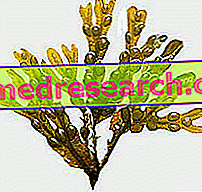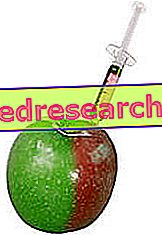Introduction
The raw materials from which sucrose is industrially extracted are mainly sugar beet (botanical species Beta vulgaris saccharifera ) and sugar cane (botanical species Saccharum officinarum ); to realize it, it is sufficient to go to any bar that respects itself and observe the sachets containing the various sweeteners. In addition to the classic cooking sugar (white), honey (not always present) and artificial sweeteners, we will probably find sachets containing cane sugar .
Most people claim that cane sugar is richer in minerals, less caloric and therefore healthier than beet. To understand if this hypothesis has a truth base or not, it is necessary to briefly analyze the path that cane sugar takes, from the cultivation of the raw material to the table of the guests.

Sugar cane
Botanical outline of sugar cane
Sugar cane is an Indian plant belonging to the Poaceae family, Genus Saccharum, Specie officinarum ; the binomial nomenclature of sugar cane is therefore Saccharum officinarum .
Uses of sugar cane
Sugar cane is a vegetable widely cultivated in tropical and subtropical regions (Cuba, Puerto Rico, Philippines, etc.).
In addition to the granulated (or granular) sugar, alcoholic beverages or pure ethyl alcohol can be obtained from this plant; the cachaça, for example, is the distillate of the sugar cane "proper", while the rum is also obtained from the distillation of the "molasses".

Cultivation of sugar cane
Sugar cane is cultivated essentially by cutting, planting small shoots in the open field between February and August (depending on the species and the local climate). Obviously, the choice of the time of grounding and the type of ground are fundamental to say the least; in fact, if these two variables are wrong, sugar cane can have a physiological production of sucrose even much lower than the average.
When fully ripe (about a year or a year and a half of life), the sugar cane reaches a height ranging from 3 to 6 meters, with a stem about 2-5 cm wide.
Production
From cane to sugar
Once ripe, the sugar cane is cut at the base, stripped of the leaves, chopped and squeezed to make a sweet juice called "light sauce".
The woody part, called "bagasse", is intended for the production of fuel; the light sauce instead, is purified with "milk of lime" and carefully filtered. Once the aqueous part is removed with an evaporation process, a particularly concentrated liquid is obtained. This is then separated by cold centrifugation to give rise to raw sugar (solid, crystallized) and molasses (liquid).
In this form, the raw cane sugar contains only about 2% of impurities and is finally ready for consumption. In some cases it is instead subjected to a further refining process, which makes it equivalent to the classic cooking sugar.
Integral VS Rough
Differences between brown cane sugar and raw cane sugar
By skipping the chemical refining process or by implementing it only in part, the so-called "whole cane sugar" is obtained. Whole cane sugar should NOT be confused with "raw cane sugar" (the most widespread); the latter, in fact, having undergone the refining process, is very similar to that obtained from beet.
Its yellow-beige color should not deceive, since it is given by the addition of small quantities of molasses or caramel.
Not being able to base on simple color, to judge the quality of a cane sugar it is necessary to observe some particular in more. If, for example, it is presented in the form of uniform crystals in terms of size and color, it is probably a raw sugar; on the contrary, if there are more or less large crystals and with different dark shades, it is easier for them to be integral sugar.
Property
Nutritional characteristics of INTEGRAL cane sugar
Compared to traditional sugar (sugar beet sucrose), the INTEGRAL cane sugar contains a lower percentage of sucrose (10-15% less), while it is richer in mineral salts (calcium, phosphorus, potassium, zinc, fluorine, magnesium ) and vitamins (A, B1, B2, B6 and C).
The caloric power is lower, so much so that 100 grams of whole cane sugar bring 356kcal against the 392kcal of the traditional white beet sucrose.
Nutritional characteristics of RAW cane sugar
The sugar commonly identifiable as cane sugar, the brown one with regular crystals (ie GREZZO), is instead almost identical to the much hated white sugar of beet.
Most of the properties attributed to it are therefore false, or rather, belong to other types of cane sugar. The crude has the same chemical composition and the same metabolic impact as white beet sucrose.
Less sweet sugar: is it worth it?
Let us consider a final alternative granular sugars based on commercially available Saccharose, including the whole cane sugar. If it is true that these, for the same mass and volume, contain LESS sugars (and hypothetically more mineral salts, vitamins, etc.), they certainly also contribute less calories; this might seem like an advantage and should direct consumers to prefer them over the traditional one. However, it is also necessary to reflect on the gustatory ROLE of sugar in nutrition, or that of EDULCORANTE or SWEETENER.
Of course, if whole sugar contains less sucrose, it also uses a LESS sweetener power. In this circumstance, with the same sense of taste, a person who prefers whole sugar is led to use MORE than the normal one, in order to reach the desired sweetness level. Ultimately, the result does not change!
The only way to eat less sugar with food is to add less in food; without this precaution, preferring the integral one has therefore no prominent beneficial impact on the organism, also because the additional nutrients that characterize it are all well present in a balanced diet.
Food Fraud
Colored Cane Sugar Buffalo
In April 2017, a video was released on the internet that attempts to prove a food fraud concerning cane sugar; Needless to say, the short film has alarmed the entire community of its usual consumers.
Let us now try to analyze the contents of the video to see if it can be considered reliable:
- Let's start badly! After the introduction, a fundamental error is already made, confusing raw cane sugar (the most widespread and used for typical single-dose packs of bars) with the integral one (instead it is less often packaged almost exclusively in large envelopes). If you don't remember the difference well, re-read the dedicated paragraph above.
- It is then alluded to that the raw sugar acquires the brown color thanks to an industrial process: "it is caramelized". That there are caramel-based food colors (E 150) is a fact; nevertheless:
- If it is true that there are white COLORED sugars with E 150 (a, b, c, d), it is equally true that it is NOT the case with raw cane! This process must be reported on the label and the omission constitutes a food fraud punishable by law. From this point of view, we are safe.
- Then, to be precise, their use does not include any "caramelization" of the final food; in fact, to be caramelized (chemical-physical process) is the additive and NOT the final product. It may seem trivial but, from a chemical-compositional point of view, it is not at all.
- As a "scientific proof" of this "terrifying industrial scam", a physical test is proposed: the raw sugar is pulverized with a pestle, highlighting that it becomes lighter, since in the center the crystals are actually white. The "litmus test" would then consist of the same treatment applied to whole sugar (here wrongly defined as "real raw sugar").
- The honesty of the Asian producers who, on the packaging of a certain brown sugar, specify the wording "caramel granulated sugar" is then praised; pity that it is not proposed the detail of the nutritional label, necessary to understand the true nature of the food. Moral of the story, in Italy caramelized sugar would be split for raw cane sugar ... FALSE!
- It is a beautiful and good slander that helps to discredit the good sources of dissemination present on the net. The brown appearance of the crystals in fact, is nothing but a residue of the molasses (see above "Production"), typically brown in color. Here is that when the crystals are pulverized, they are richer in white matter than in the dark, a light compound is obtained. The same does not happen for the integral cane sugar which, without refining, is "impure" and crystallizes in small brown flakes.
Use of cane sugar in the kitchen
Video Recipes with Cane Sugar »



